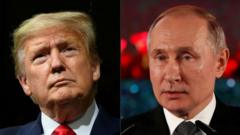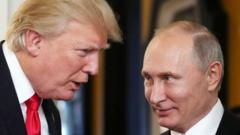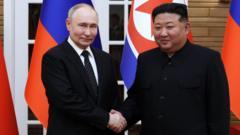As US Treasury Secretary Scott Bessent suggests the possibility of additional tariffs on India contingent upon President Trump’s discussions with President Putin, the dynamics of US-India relations are tested amidst ongoing tensions surrounding Russian oil imports.
US Threatens Further Tariffs on India Linked to Trump-Putin Meeting

US Threatens Further Tariffs on India Linked to Trump-Putin Meeting
Washington warns of increased sanctions depending on the outcome of the upcoming peace talks between the US and Russia.
US Treasury Secretary Scott Bessent issued a stark warning regarding potential future tariffs on India, contingent upon the outcome of a pivotal meeting between President Donald Trump and Russian President Vladimir Putin scheduled for Friday in Anchorage, Alaska. In a recent interview with Bloomberg TV, Bessent conveyed that if negotiations do not yield positive results, the US may impose additional secondary tariffs on Indian imports, particularly in light of India's recent purchases of Russian oil.
Following an earlier 25% tariff imposed on India for its dealings with Russia, which included oil and weaponry transactions, Bessent indicated that economic repercussions could escalate. Trump’s administration has been actively seeking a resolution to the conflict in Ukraine, and Bessent emphasized that the failure to establish a peace agreement could exacerbate tensions, affecting trade relationships and energy diplomacy.
India’s imports of Russian crude oil surged in 2024, making up 35% to 40% of its total oil imports, markedly increasing from a mere 3% in 2021. In response to the West's criticism, India has defended its strategy, arguing that as a major energy consumer, securing affordable oil is paramount to shield its vulnerable populations from rising fuel prices.
After labeling India as "a bit recalcitrant" in recent trade negotiations, Bessent criticized the Indian government's stance on tariffs during a Fox Business interview. Trump has consistently framed these tariffs as necessary measures to bolster the US economy while simultaneously pushing to address the significant $45 billion trade gap with India.
In the runup to renewed trade talks set for August 25, experts are wary that India’s resistance to reducing tariffs on agricultural goods could hinder any meaningful progress. The new 50% tariff rate, effective August 27, has been described as an effective embargo on US-India trade, potentially rendering India the most heavily taxed US trading partner in Asia. This shift could heavily impact India's export-driven sectors like textiles and jewelry while threatening to dampen the country's economic growth by as much as half a percentage point. As the stakes rise, the international community watches closely, hoping the upcoming summit can alleviate some of the growing tensions.





















